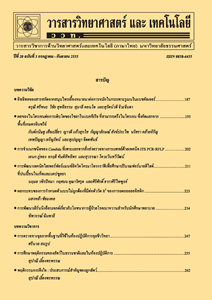พฤติกรรมการบดอัดของทรายหล่อแบบและดินเหนียวที่ปรับปรุงด้วยทรายหล่อแบบ
Main Article Content
Abstract
บทคัดย่อ
งานวิจัยนี้ได้นำทรายหล่อแบบกลุ่ม Green Sand Waste (GSW) และ Shell Sand Waste (SSW) ซึ่งเป็นผลพลอยได้จากอุตสาหกรรมการผลิตชิ้นส่วนรถยนต์มาศึกษาพฤติกรรมการบดอัดเพื่อนำมาประยุกต์ใช้ในงานทาง และใช้ในการปรับปรุงคุณภาพดินเหนียวมีพลาสติกซิตี้สูง (CH) ในสัดส่วนการแทนที่ 20, 40, 60 และ 80% โดยน้ำหนัก จากการศึกษาพบว่ามีความเป็นไปได้ที่จะนำทรายหล่อแบบทั้งสองกลุ่มไปประยุกต์ใช้ในงานทาง เนื่องจากมีคุณสมบัติผ่านตามมาตรฐานโดยกลุ่ม GSW มีค่า CBR แบบแช่น้ำทางด้านแห้ง (-2% จาก OMC) และด้านเปียก (+2% จาก OMC) เท่ากับ 16.02% และ 11.13% มีการบวมตัวที่ 4 วันทั้งด้านแห้งและด้านเปียกอยู่ที่ 1.53% และ 0.73% ส่วนกลุ่ม SSW มีค่า CBR แบบแช่น้ำทางด้านแห้งและด้านเปียกเท่ากับ 24.84% และ 4.72% มีการบวมตัวทางด้านแห้งเท่ากับ 0.58% ทางด้านเปียกไม่มีการบวมตัว ส่วนดินเหนียวที่ปรับปรุงคุณภาพโดยการผสมกับทรายหล่อแบบนั้นพบว่าผลจากการเพิ่มปริมาณของทรายหล่อแบบส่งผลให้ค่าความหนาแน่นแห้งสูงสุดเพิ่มขึ้น, ค่า OMC ลดลง, ค่า CBR แบบแช่น้ำเพิ่มขึ้นเล็กน้อย และเปอร์เซ็นต์การบวมตัวลดลง
คำสำคัญ : ทรายหล่อแบบ; การบดอัด; ดินเหนียว
Abstract
This research studied the compaction behavior of Green Sand Waste (GSW) and Shell Sand Waste (SSW) which were by-products from engine parts casting industry in order to use them as highway materials. In addition, a potential to be used as admixtures for a high plasticity clay (CH) was investigated by varying mixing ratio by weight from 20, 40, 60 to 80%. From the results, it is possible to use both waste foundry sands for highway construction materials since their properties satisfy with the standard. The soaked CBR values of GSW on dry side (-2% from OMC) and wet side (+2% from OMC) were 16.02% and 11.13% respectively and the swelling in 4 days were 1.53% for dry side and 0.73% for wet side. The soaked CBR values of SSW on dry side and wet side were 24.84% and 4.72% respectively and the swelling in 4 days were 0.58% for dry side and 0% for wet side. For clay improved by waste foundry sand, it was found that the increasing of both waste foundry sand increased the maximum dry density, decreased the optimum moisture content, slightly increased the soaked CBR values and decreased the percent swelling.
Keywords: waste foundry sand; compaction; clay


